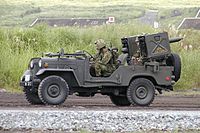| Type 64 MAT | |
|---|---|
| Type | MCLOS wire-guided Anti-tank missile |
| Place of origin |
|
| Service history | |
| In service | 1964 - present[1] |
| Used by |
|
| Production history | |
| Designer | Defense Agency Technical Research and Development Institute[2] |
| Designed | 1957 |
| Manufacturer | Kawasaki Heavy Industries |
| Produced | 1964 |
| No. built | 220[3] |
| Specifications | |
| Mass | 15.7 kg |
| Length | 1.02 m |
| Diameter | 0.12 m |
| Crew | 3 |
|
| |
| Effective firing range | 350 to 1,800 m |
| Warhead | Hollow charge |
|
| |
| Engine | Two-stage solid rocket motor - first stage rated at 130 kg static thrust, second stage rated at 15 kg static thrust. |
| Maximum speed | 306 km/h |
Guidance system | MCLOS system |
The Type 64 MAT (64式対戦車誘導弾 64-shiki tai-sensha yūdō-dan[4]) was a Japanese wire guided anti-tank missile developed during the late 1950s. The missile is a broadly similar to the Swiss/German Cobra and the 9M14 Malyutka. Within the JGSDF, it is also known as 64MAT and KAM-3.[5]
History[]
Development of the missile began in 1957, and was adopted as standard equipment for the Japanese Ground Self-Defense Forces with the official designation Type 64 ATM in 1964. Kawasaki Heavy Industries had been responsible for manufacturing the Type 64.[6]
Though the Type 64 MAT had been largely phased out and replaced by the Type 79 Jyu-MAT and Type 87 Chu-MAT as front-line anti-tank missiles in the 1970s to the 1990s, a small number are being held as reserve missiles.
Description[]
The missile is cruciform in cross-section with four large wings. It is powered by a dual thrust rocket motor, which accelerates the missile to its cruising speed in 0.8 seconds.
Operational use[]
The missile is launched from an open framed launcher at an angle of 15 degrees. The operator steers the missile using a control box, which sends commands down a wire that is trailed from the missile. A gyroscope in the missile compensates for pitch and yaw.[2]

Mitsubishi Type 73 jeep with two Type 64 anti-tank missile pods.
The Type 64 is typically operated by a three man crew. It can also be deployed from a Mitsubishi Type 73 Jeep, which can carry four missiles.[2]
Similar missile systems[]
See also[]
References[]
- ↑ The missile has gradually phased out, although is still kept in reserve
- ↑ 2.0 2.1 2.2 "64式 対戦車誘導弾" (in Japanese). http://rightwing.sakura.ne.jp/equipment/jgsdf/firearms/type64mat/type64mat.html. Retrieved 2009-11-04. Cite error: Invalid
<ref>tag; name "Missile" defined multiple times with different content - ↑ "Index of Japanese Military Equipment - Index des équipements militaires japonais" (in English and French). http://armyreco.ifrance.com/asie/japon/japon_index_materiel.htm. Retrieved 2009-01-12.
- ↑ taisensha yuudoudan = Anti-tank guided missile
- ↑ Andreas Parsch (2004-03-16). "Japanese Military Aircraft Designations (after 1945)". http://www.designation-systems.net/non-us/japan.html. Retrieved 2009-01-12.
- ↑ "Type-87 anti-tank missile". Federation of American Scientists. 1999-08-10. http://www.fas.org/man/dod-101/sys/missile/row/type-87.htm. Retrieved 2009-01-12.
- Kenkyusha's New Japanese-English Dictionary, Kenkyusha Limited, Tokyo 1991, ISBN 4-7674-2015-6
Biography[]
- Brassey's Infantry Weapons of the World, J.I.H. Owen.
- Jane's Infantry Weapons 1991-92, Ian V. Hogg.
- Brassey's Anti-tank weapons, John Norris
| Wikimedia Commons has media related to Type 64 MAT. |
The original article can be found at Type 64 MAT and the edit history here.